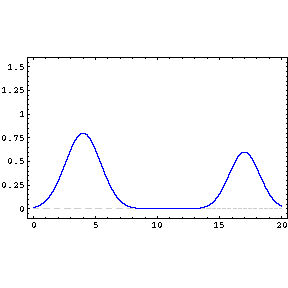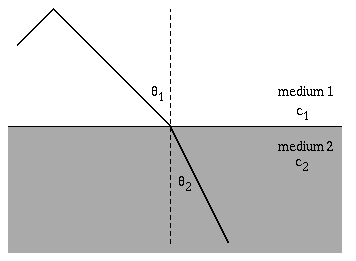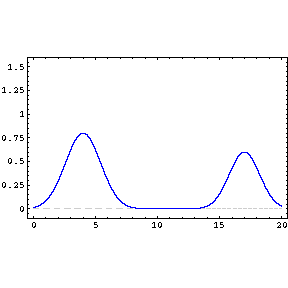Types Of Waves Quiz Questions
(282).jpg)
Basic quiz on waves, light, sound, refraction, reflection, interference
- 1.
In this animation, what type of wave is shown?
- A.
Transverse
- B.
Refracted
- C.
Longitudinal
- D.
Light
Correct Answer
C. LongitudinalExplanation
The correct answer is longitudinal. In the animation, the wave is shown moving in a back-and-forth motion, with the particles of the medium vibrating parallel to the direction of the wave. This is characteristic of a longitudinal wave, where the disturbance travels in the same direction as the wave itself.Rate this question:
-
- 2.
The material that a wave travels through is called the
- A.
Refraction
- B.
Medium
- C.
Reflection
- D.
Speed
Correct Answer
B. MediumExplanation
The correct answer is "medium" because in the context of waves, the medium refers to the material or substance through which the wave travels. It could be a solid, liquid, or gas. The properties of the medium, such as density and elasticity, determine how the wave behaves and travels. Refraction, reflection, and speed are all related concepts but do not directly refer to the material through which the wave travels.Rate this question:
-
- 3.
The type of wave shown is a __________ wave.
Correct Answer
transverse, TransverseExplanation
In a transverse wave, the particles of the medium vibrate perpendicular to the direction of wave propagation. The image shows a wave with peaks and troughs, which is characteristic of a transverse wave. Light waves and water waves are examples of transverse waves.Rate this question:
- 4.
In this animation what kind of interference is shown?
- A.
Destructive
- B.
Constructive
- C.
Refraction
- D.
Reflection
Correct Answer
B. ConstructiveExplanation
The animation shown in the question demonstrates constructive interference. Constructive interference occurs when two waves combine to create a resulting wave with a larger amplitude. In the animation, it is likely that two waves are overlapping and their crests align, resulting in a wave with a higher amplitude. This is characteristic of constructive interference.Rate this question:
-
- 5.
____________ is when a wave, like light, bounces off an object.
Correct Answer
reflection, reflecting, reflectiveExplanation
Reflection is the phenomenon where a wave, such as light, bounces off an object. It occurs when a wave encounters a surface and changes direction, returning back into the medium it came from. This change in direction is caused by the wave interacting with the molecules or particles of the object's surface. Reflection plays a crucial role in various aspects of our daily lives, from allowing us to see our reflection in a mirror to enabling us to see objects through the reflection of light.Rate this question:
- 6.
What property of waves is shown in the animation?
Correct Answer
refraction
refractingExplanation
The animation in question is demonstrating the property of refraction. Refraction refers to the bending of waves as they pass from one medium to another, caused by a change in the wave's speed. In the animation, the waves are clearly shown changing direction as they enter a different medium, indicating the phenomenon of refraction. The term "refracting" is also mentioned in the answer, which further supports the explanation as it is the verb form of refraction and refers to the action of bending the waves.Rate this question:
- 7.
Which of the following is not a type of electromagnetic wave?
- A.
Sound
- B.
Red light
- C.
Gamma rays
- D.
Radio waves
- E.
Microwaves
Correct Answer
A. SoundExplanation
Sound is not a type of electromagnetic wave. Unlike electromagnetic waves, sound waves require a medium to travel through, such as air, water, or solids. Sound waves are mechanical waves that result from the vibration of particles in a medium, while electromagnetic waves are transverse waves consisting of oscillating electric and magnetic fields that can travel through a vacuum.Rate this question:
-
- 8.
All waves except __________ waves must travel through a medium.
- A.
Sound
- B.
Light
- C.
Water
- D.
Compressional
Correct Answer
B. LightExplanation
Light waves are the only type of waves that can travel through a vacuum or empty space, without the need for a medium. Sound waves, water waves, and compressional waves all require a medium, such as air, water, or a solid, in order to propagate. Therefore, the correct answer is light.Rate this question:
-
- 9.
Points A and F onthe wave are ________
Correct Answer
crest
crestsExplanation
Points A and F on the wave are located at the highest points of the wave, which are called crests. A crest refers to a single highest point, while crests indicate multiple highest points in a wave.Rate this question:
- 10.
Points B, E, G, and J on the wave are _______________.
Correct Answer
node
nodesExplanation
Points B, E, G, and J on the wave are referred to as nodes. In a wave, nodes are the points where the amplitude is always zero. These points do not experience any displacement from their equilibrium position. In this case, since there are multiple points mentioned (B, E, G, and J), they are referred to as nodes (plural).Rate this question:
- 11.
Points D and I on the wave are __________________.
Correct Answer
trough
troughsExplanation
Points D and I on the wave are troughs. A trough is the lowest point on a wave, where the displacement of the medium is at a minimum. In this case, since the answer includes both "trough" and "troughs," it suggests that there may be multiple troughs on the wave, with D and I representing two of them.Rate this question:
- 12.
The distance between A and F is the _____________.
- A.
Frequency
- B.
Period
- C.
Amplitude
- D.
Wavelength
Correct Answer
D. WavelengthExplanation
The distance between A and F is referred to as the wavelength. Wavelength is a term used in physics to describe the distance between two consecutive peaks or troughs in a wave. It is a characteristic property of waves and is commonly used to measure the length of electromagnetic waves such as light or radio waves. In this context, the distance between A and F can be understood as the distance between two points on a wave, indicating that the correct answer is wavelength.Rate this question:
-
- 13.
The distance from the dotted line to Point A, or the distance from the dotted line to Point D is known as the ______________.
- A.
Frequency
- B.
Period
- C.
Amplitude
- D.
Wavelength
Correct Answer
C. AmplitudeExplanation
The distance from the dotted line to Point A or Point D is known as the amplitude. Amplitude refers to the maximum displacement or distance from the equilibrium position in a wave or oscillation. In this context, it represents the maximum distance that Point A or Point D deviates from the dotted line.Rate this question:
-
- 14.
this image shows an example of:
- A.
Reflection
- B.
Refraction
- C.
Penumbra
- D.
A broken straw
Correct Answer
B. RefractionExplanation
The image provided is an example of refraction. Refraction occurs when light passes through a medium and changes direction due to a change in its speed. In the image, the light rays are clearly bending as they pass through the medium, indicating the phenomenon of refraction.Rate this question:
-
- 15.
The wave speed equation is v = frequency x wavelength.If the frequency of a wave is 500Hz and the wavelength is 2m, how fast is the wave moving?
- A.
25 m/s
- B.
250 m/s
- C.
1000 m/s
- D.
10,000 m/s
Correct Answer
C. 1000 m/sExplanation
The wave speed equation states that the speed of a wave is equal to the product of its frequency and wavelength. In this question, the frequency is given as 500Hz and the wavelength is given as 2m. By plugging these values into the equation, we can calculate the wave speed as 500Hz x 2m = 1000 m/s. Therefore, the wave is moving at a speed of 1000 m/s.Rate this question:
-
- 16.
The wave speed equation is v = frequency x wavelength.If the velocity of the wave is 400 m/s and the wavelength is 2m, what is its frequency?
- A.
200 Hz
- B.
800 Hz
- C.
20 Hz
- D.
400 Hz
Correct Answer
A. 200 HzExplanation
The wave speed equation v = frequency x wavelength can be rearranged to solve for frequency, which is v/wavelength. In this case, the velocity of the wave is given as 400 m/s and the wavelength is given as 2m. By substituting these values into the equation, we get 400 m/s / 2m = 200 Hz. Therefore, the frequency of the wave is 200 Hz.Rate this question:
-
- 17.
In this example of constructive interference, what increases?
- A.
Wavelength
- B.
Frequency
- C.
Speed
- D.
Amplitude
Correct Answer
D. AmplitudeExplanation
In constructive interference, two waves combine to form a wave with a larger amplitude. This means that the height or intensity of the wave increases. Therefore, in this example, the correct answer is amplitude.Rate this question:
-
Quiz Review Timeline +
Our quizzes are rigorously reviewed, monitored and continuously updated by our expert board to maintain accuracy, relevance, and timeliness.
-
Current Version
-
Nov 24, 2024Quiz Edited by
ProProfs Editorial Team -
Apr 30, 2015Quiz Created by
Leeroy7
 Back to top
Back to top













